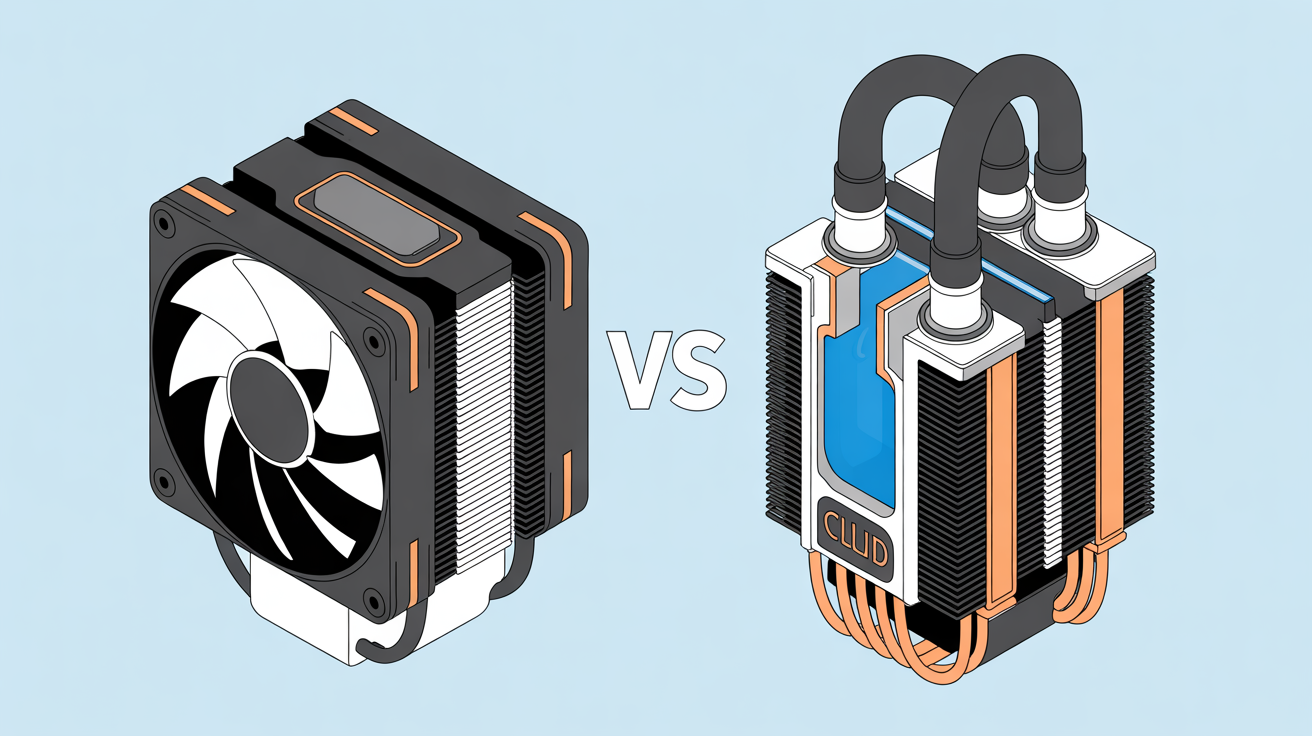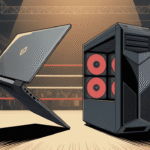Your CPU is the brain of your computer, performing billions of calculations every second. This intense activity generates heat, and managing that heat is crucial for optimal performance and the longevity of the component. If a CPU gets too hot, it will automatically slow down (a process called thermal throttling), to prevent damage. In 2025, with CPUs becoming ever more powerful and power-hungry, choosing the right cooling solution is more important than ever.
Two primary technologies dominate the CPU cooling market: air cooling and liquid cooling. Both have their strengths and weaknesses, and the best choice for you depends heavily on your specific needs, budget, and build goals. This guide will break down everything you need to know to make an informed decision for your PC.
Understanding CPU Heat and TDP
Every CPU has a Thermal Design Power (TDP) rating, measured in watts (W). TDP represents the maximum amount of heat a cooling system is expected to dissipate while the CPU is under typical heavy load. It’s not the CPU’s power consumption itself, but rather a guideline for cooler manufacturers. A CPU with a higher TDP requires a more robust cooling solution to maintain performance.
When a CPU’s temperature rises beyond a safe threshold, its internal sensors trigger thermal throttling. This means the CPU reduces its clock speed and voltage to lower heat output. While this protects the CPU from damage, it directly impacts performance, leading to stuttering in games or slower completion times in demanding tasks. An effective cooler prevents this throttling, allowing your CPU to perform at its maximum potential consistently.
Air Cooling Explained: The Fundamentals

Air cooling is the traditional and most common method of keeping a CPU cool. It relies on simple, proven principles of heat transfer.
How Air Coolers Work
The core of an air cooler is the heatsink. This is a large block, typically made of copper or aluminum, attached directly to the CPU. Heat from the CPU is transferred to the heatsink base, then travels up through heat pipes (usually copper) to a large array of fins. A fan is mounted to the heatsink to blow air through these fins, rapidly dissipating the heat into the surrounding air inside the PC case.
Key Components:
- Heatsink: Composed of a base (contacting the CPU), heat pipes, and fins. The large surface area of the fins allows for efficient heat transfer to the air.
- Fan(s): Attached to the heatsink, responsible for moving air through the fins. Fan size (common sizes are 120mm and 140mm) and speed (RPM) significantly impact cooling performance and noise levels.
Air coolers are relatively simple devices with few points of failure, contributing to their reliability. They come in various sizes, from small downdraft coolers suitable for compact systems to massive dual-tower coolers designed for high-end CPUs.
Advantages of Air Cooling

Air cooling remains popular in 2025 for several compelling reasons.
Cost-Effectiveness
Generally, air coolers offer a significantly lower upfront cost compared to liquid cooling solutions. This makes them an attractive option for budget-conscious builds or users who don’t require extreme cooling performance. You can get very capable air coolers for a fraction of the price of even entry-level AIO liquid coolers.
Reliability and Longevity
With fewer moving parts than liquid coolers (primarily just the fan), air coolers are less prone to mechanical failure. There’s no pump to break and no liquid to potentially leak. A quality air cooler can reliably cool your CPU for many years, often outlasting other components in the system.
Simplicity and Ease of Installation
Installing an air cooler is typically a straightforward process. It usually involves mounting a backplate (or using the motherboard’s stock one), securing the heatsink with a few screws or clips, and attaching the fan(s). There’s no concern about radiator placement, tubing runs, or liquid levels, making it less daunting for first-time builders.
Disadvantages of Air Cooling

Despite their advantages, air coolers do have some limitations, particularly in high-performance scenarios.
Potential Size Constraints
High-end air coolers, especially dual-tower designs, can be quite large and heavy. Their significant height might interfere with the clearance of some PC cases, and their width can potentially block the first (or even second) RAM slot, limiting your choice of RAM or requiring low-profile modules. Always check cooler dimensions against your case and motherboard specifications.
Performance Limits for High-End CPUs/Overclocking
While top-tier air coolers can handle moderately powerful CPUs and light overclocking, they may struggle to dissipate the heat generated by the hottest CPUs (those with very high TDPs, often found in high-end gaming or workstation builds) when pushed to their limits or heavily overclocked. Liquid cooling often offers a performance edge in these extreme scenarios.
Aesthetics (Subjective)
This is largely a matter of personal preference, but large air coolers can dominate the inside of a PC case. They might obstruct the view of other components like decorative RAM or motherboard heatsinks. While many modern air coolers incorporate attractive designs and RGB lighting, their sheer size can be less visually appealing to some compared to the cleaner look of a liquid cooler’s CPU block.
Summary of Air Cooling Pros & Cons:
- Pros: Affordable, Reliable, Easy Installation.
- Cons: Can be large (size constraints), Performance limits for very high-end/overclocked CPUs, Aesthetics might not appeal to everyone.
Liquid Cooling Explained: The Principles

Liquid cooling, also known as water cooling, uses the higher thermal conductivity of liquid to transfer heat more efficiently than air.
How Liquid Coolers Work
A CPU block with a cold plate (usually copper) is mounted directly onto the CPU. Inside this block, liquid coolant flows, absorbing the heat from the CPU. The heated liquid is then pumped through tubing to a radiator, typically mounted elsewhere in the PC case. As the liquid flows through the radiator’s fins, fans blow air through the fins, cooling the liquid. The cooled liquid then returns to the CPU block to repeat the cycle.
Key Components:
- CPU Block: Sits on the CPU, containing channels for coolant flow and a cold plate to absorb heat.
- Pump: Circulates the coolant through the loop. Often integrated into the CPU block or the radiator.
- Radiator: A heat exchanger with fins, where fans blow air to cool the liquid. Radiators come in various sizes (e.g., 120mm, 140mm, 240mm, 280mm, 360mm, 420mm), corresponding to the number and size of fans they accommodate.
- Tubing: Connects the CPU block to the radiator, transporting the coolant.
Liquid cooling offers a different approach to heat dissipation, moving the heat away from the CPU socket to a larger area where it can be released more effectively.
Types of Liquid Cooling Systems

There are two main categories of liquid cooling systems available to PC builders.
All-in-One (AIO) Coolers
AIO coolers are closed-loop systems that come pre-assembled, pre-filled with coolant, and require no maintenance (like refilling) under normal operation. They consist of a CPU block/pump combo connected by two tubes to a radiator with fans. AIOs offer a balance of performance, relative ease of installation (compared to custom loops), and aesthetics. They are the most popular form of liquid cooling for mainstream users.
Custom Loop Systems
Custom loops are modular systems where the user selects and assembles individual components: CPU block, GPU block (optional), pump, reservoir, radiator(s), tubing (hard or soft), fittings, and coolant. These systems offer the highest performance and maximum customization in terms of aesthetics (colored coolant, unique tube routing, etc.). However, they are significantly more expensive, complex to plan and build, and require regular maintenance (draining, cleaning, refilling).
Advantages of Liquid Cooling

Liquid cooling offers distinct benefits, particularly for enthusiasts and those with demanding hardware.
Superior Cooling Performance
Liquid has a higher thermal conductivity than air, allowing it to absorb and transfer heat more effectively. This often results in lower CPU temperatures, especially under heavy load or during prolonged gaming sessions. This superior performance is crucial for cooling high-TDP CPUs and maximizing overclocking potential.
Compact CPU Block Size
While the radiator requires mounting space elsewhere in the case, the CPU block itself is typically much smaller and lower profile than a large air heat sink. This leaves more clearance around the CPU socket for tall RAM modules with elaborate heat spreaders and provides an unobstructed view of the motherboard’s details.
Enhanced Aesthetics and Customization
Liquid cooling systems often provide a cleaner, more modern look inside a PC case, with sleek CPU blocks and radiators mounted discreetly. Custom loops take this further, allowing for personalized tube routing, colored coolants, and elaborate RGB lighting on blocks, pumps, and fans, creating truly unique builds. AIOs also frequently include integrated RGB lighting.
Summary of Liquid Cooling Advantages:
- Superior cooling performance, especially for high heat loads.
- Compact CPU block size, allowing for more RAM clearance.
- Often provides cleaner aesthetics and more customization options.
Disadvantages of Liquid Cooling

While powerful, liquid cooling comes with its own set of drawbacks.
Higher Cost
Liquid cooling systems, especially custom loops, are significantly more expensive than comparable air coolers. Even AIOs typically cost more than mid-range to high-end air coolers. This higher price point is a major factor for many builders.
Increased Complexity and Installation Difficulty
Installing an AIO is more involved than installing an air cooler, requiring careful placement of the radiator and routing of tubes. Custom loops are the most complex, requiring significant planning, measuring, cutting tubing, installing fittings, filling the loop, and bleeding air – a process that requires patience and attention to detail.
Potential for Leaks or Pump Failure
Although rare with modern, quality components, there is an inherent risk of leaks in liquid cooling systems. A leak can potentially damage other components in your PC. Additionally, the pump is a mechanical part that can fail over time. While AIOs are designed to be sealed and reliable, these potential points of failure exist in a way they do not with air coolers.
Summary of Liquid Cooling Disadvantages:
- More expensive upfront cost.
- More complex installation process.
- Small, but present, risk of leaks or pump failure.
Critical Factors for Choosing Your Cooler

Selecting the right CPU cooler involves more than just picking air or liquid. Several practical considerations should guide your decision.
CPU’s Thermal Design Power (TDP)
This is perhaps the most critical factor. Check the TDP of your specific CPU. A simple 65W CPU won’t need the same cooling power as a high-end 150W+ CPU designed for overclocking. Cooler manufacturers usually list the maximum TDP their product can effectively handle. Ensure the cooler’s capacity meets or exceeds your CPU’s requirements.
PC Case Compatibility
Case size and design heavily influence cooler choice. For air coolers, check the maximum CPU cooler height your case supports. For liquid coolers, identify where your case has mounting points for radiators (front, top, rear) and what radiator sizes (120mm, 240mm, 360mm, etc.) it accommodates. Also, consider if a large air cooler might block fan mounts or cable routing points.
Your Budget
Determine how much you are willing to allocate for your cooling solution. Air coolers offer excellent performance per dollar for most applications. AIO liquid coolers sit in a mid-range price bracket, offering a step up in performance and aesthetics. Custom loops represent a significant investment reserved for enthusiasts seeking maximum performance and customization regardless of cost.
Desired Noise Levels
All coolers use fans, and fans generate noise. Air coolers typically have 1-2 large fans directly on the heatsink. Liquid coolers have fans on the radiator, plus a pump which also generates some noise. The size and speed of the fans, the quality of the pump, and the overall design of the cooler impact noise levels. Larger fans spinning slower are often quieter than smaller fans spinning faster. Some users prioritize silence and might choose specific low-noise fan models or larger radiators that allow fans to spin slower.
Summary of Critical Factors:
- CPU TDP is paramount for determining required cooling capacity.
- Case compatibility (height for air, radiator mounts for liquid) is essential.
- Budget dictates the tier of cooler you can afford.
- Consider desired noise levels based on fan and pump noise profiles.
Performance Showdown: Air vs. Liquid

When it comes down to raw thermal performance, particularly under heavy load and with high-end CPUs, liquid cooling often has an edge.
Comparing Thermal Performance under Load
In benchmarks and demanding applications, AIO and custom liquid coolers generally achieve lower peak temperatures and recover faster from thermal spikes than air coolers, especially when cooling high-TDP processors. This is due to the efficiency of liquid in absorbing and transferring heat away from the CPU to a larger radiator surface area. While high-end air coolers can compete with smaller AIOs (like 120mm or 240mm radiators) on mid-range CPUs, larger radiators (280mm, 360mm+) on liquid coolers typically outperform even the biggest air heatsinks.
Impact on Overclocking Potential
Lower temperatures directly translate to greater thermal headroom. When a CPU stays cooler, it can often sustain higher clock speeds for longer periods without hitting thermal throttling limits. This is where liquid cooling, particularly larger AIOs and custom loops, shines for enthusiasts looking to push their CPU’s performance beyond stock settings through overclocking. While air cooling can support mild overclocking, liquid cooling provides the best foundation for achieving maximum stable overclocks on high-end hardware.
| Feature | Air Cooling | Liquid Cooling (AIO) | Liquid Cooling (Custom Loop) |
|---|---|---|---|
| Peak Performance | Good to Excellent (depends on size) | Excellent | Outstanding (highest potential) |
| Best for TDP | Low to High (up to ~130-150W effectively) | Medium to Very High (up to ~200W+ effectively) | Extreme (200W+, extreme overclocking) |
| Overclocking | Mild to Moderate | Moderate to High | Highest Potential |
| Complexity | Low | Medium | High (Requires planning and skill) |
Noise Level Comparison

Noise is a significant consideration for many PC users. Both air and liquid coolers generate noise, primarily from fans, but liquid coolers also have a pump.
Fan Noise vs. Pump/Fan Noise
Air coolers produce noise primarily from the one or two fans mounted directly on the heat sink. The sound profile is generally a consistent whooshing or humming of airflow. Liquid coolers have fans on the radiator, which produce similar airflow noise, but also a pump that generates a distinct, often low-level humming or buzzing sound. While modern pumps are much quieter than older designs, they are an additional noise source not present in air coolers.
Factors Influencing Noise:
- Fan Size and Speed: Larger fans spinning at lower RPMs generally move the same amount of air as smaller fans spinning faster, but with less noise.
- Radiator Size (Liquid): A larger radiator allows fans to spin slower to dissipate the same amount of heat, potentially reducing noise.
- Pump Quality (Liquid): The design and quality of the pump significantly impact its noise level.
- Overall Design: The design of heatsink fins (air) or radiator fins and fan blades impacts airflow turbulence and noise.
Silent PC builds often require careful selection of low-noise fans and possibly larger coolers (both air and liquid) to allow fans to run at lower speeds. Some users are more sensitive to the pump noise of liquid coolers than the fan noise of air coolers.
Installation and Maintenance Considerations

The ease of installation and the need for ongoing maintenance differ between air and liquid cooling.
Installing Air Coolers
Installation typically involves attaching mounting brackets to the motherboard (often with a backplate), applying thermal paste to the CPU, placing the heatsink on the CPU, and securing it with screws or clips. Finally, the fan(s) are clipped or screwed onto the heatsink. The main challenges are often maneuvering around other components and ensuring the heatsink is properly seated with even pressure.
Installing Liquid Coolers (AIO vs. Custom)
AIO installation involves mounting the CPU block to the motherboard (similar to an air cooler base), mounting the radiator and its fans to a designated location in the case, and routing the tubing. This requires a bit more planning to find the best radiator placement. Custom loop installation is significantly more complex, requiring planning the loop order, cutting tubing precisely, installing fittings, filling the reservoir, and carefully bleeding all air from the system before powering on. This process can take several hours, even for experienced builders.
Required Maintenance for Each Type
Air coolers require minimal maintenance – primarily dusting the heatsink fins and fan blades periodically to prevent dust buildup, which can impede airflow and performance. Liquid coolers (AIOs) are generally considered maintenance-free for their lifespan, though dusting the radiator fans is still necessary. Custom loops require more involved maintenance: checking coolant levels, occasionally topping up, and periodically draining, cleaning, and refilling the loop (recommended every 1-2 years depending on coolant type) to prevent buildup or degradation of components.
Summary of Installation & Maintenance:
- Air cooling is the easiest to install and requires minimal maintenance (dusting).
- AIO liquid cooling is more complex to install but generally maintenance-free besides dusting.
- Custom liquid cooling is the most complex to install and requires periodic draining and refilling.
Aesthetics and Personal Preference
The visual appeal of a PC build is important to many users. CPU coolers are often prominent components that significantly impact the overall look.
Visual Impact of Air vs. Liquid Coolers
Large tower air coolers make a strong visual statement, often filling a significant portion of the motherboard area. They can look robust and functional. Liquid coolers, with their smaller CPU block and separated radiator, generally offer a cleaner look around the CPU socket. The radiator can be mounted in a less visible location.
RGB Lighting and Customization
Both air and liquid coolers have embraced RGB lighting. Many modern air coolers feature RGB fans and sometimes illuminated top covers. AIO liquid coolers frequently have RGB lighting on the CPU block and/or the radiator fans. Custom loops offer the highest level of aesthetic customization with options for clear or colored tubing, various coolant colors (opaque, transparent, UV reactive), and RGB lighting on almost every component in the loop (blocks, pump, reservoir, fans).
Ultimately, the choice between the look of a large heatsink and fans versus a sleek CPU block and separated radiator comes down to personal taste and the desired theme of the PC build.
Air vs. Liquid: Which is Right for Your PC in 2025?

The “perfect” CPU cooler isn’t a one-size-fits-all solution. The best choice depends on aligning the cooler’s capabilities and characteristics with your specific hardware, budget, and goals for your PC build in 2025.
Matching the Cooler to Your Needs:
- Basic/Mid-Range Builds (Lower TDP CPUs, e.g., Intel Core i3/i5, AMD Ryzen 3/5): A good quality air cooler is usually more than sufficient. It’s cost-effective, reliable, and easy to install, providing excellent performance for typical tasks and gaming.
- High-End Gaming/Workstation Builds (High TDP CPUs, e.g., Intel Core i7/i9, AMD Ryzen 7/9): Both high-end air coolers and AIO liquid coolers (240mm radiator or larger) are viable options. If you don’t plan to overclock heavily, a top-tier air cooler can offer competitive performance while being more reliable and cheaper. If you seek maximum thermal headroom or prefer the aesthetics, a large AIO is a strong contender.
- Overclocking Enthusiasts (Pushing performance limits): Liquid cooling, particularly 280mm or 360mm AIOs, or a custom loop, provides the best cooling performance to maintain stability at higher clock speeds.
- Silent Builds: Look for coolers (both air and liquid) with larger heatsinks/radiators and high-quality, low-RPM fans. Some air coolers can be very quiet, while larger AIOs allow fans to spin slower. Pay attention to pump noise specifications for liquid coolers.
- Compact Builds (Small Form Factor PCs): Case restrictions become critical. Some cases only support low-profile air coolers or specific small AIO radiators (like 120mm or 140mm). Always check case specifications meticulously.
Consider your primary use case, the specific CPU you’ve chosen (and its TDP), your case’s limitations, and your comfort level with installation complexity when making your choice.
Recommended CPU Cooler Picks for 2025
Based on performance, value, and specific use cases highlighted in current reviews, here are a couple of recommended CPU coolers for both air and AIO liquid categories in 2025.
Air Cooler Recommendations
Air coolers offer a fantastic balance of performance, reliability, and value for many PC builds.
- Noctua NH-D15 G2: Cited as the best overall air cooler available in 2025, the NH-D15 G2 is a dual-tower, dual-fan mammoth capable of competing with some liquid coolers. It excels in cooling performance and quiet operation thanks to its large heatsinks and high-quality fans, though its size might be a concern for smaller cases or tall RAM. The original Noctua NH-D15 is also noted as an elite performer, particularly for AM4 sockets.
- Be Quiet! Pure Rock 2: If you’re looking for an excellent budget-friendly air cooler, the Be Quiet! Pure Rock 2 is a top pick. It provides significantly better cooling than stock coolers and operates very quietly for its price, making it suitable for low to mid-range CPUs.
AIO Liquid Cooler Recommendations
For those seeking maximum cooling performance or a specific aesthetic, AIO liquid coolers are a popular choice.
- Corsair iCUE H100i Elite Capellix XT: This is a highly-rated AIO liquid cooler noted for consistent temperature control and is listed among the best liquid CPU coolers in 2025. While details in the provided context are limited, the Corsair H100i series is a widely recognized name in the AIO market.
- DeepCool LS520: The DeepCool LS520 is another solid AIO liquid cooler recommended in 2025 lists. DeepCool is mentioned as a trusted brand offering reliable CPU coolers.
Conclusion: Making an Informed Decision
In 2025, the choice between air and liquid cooling for your CPU remains a key decision in building or upgrading a PC. Air cooling provides a reliable, cost-effective, and simpler solution suitable for most users and CPU configurations, prioritizing ease of installation and longevity. Liquid cooling, particularly AIOs, offers enhanced thermal performance crucial for high-end CPUs and overclocking, alongside often cleaner aesthetics, though at a higher price point and with slightly greater complexity and potential (albeit rare) failure points like pump failure or leaks.
Ultimately, the best cooler for you hinges on balancing the required cooling performance for your specific CPU (based on its TDP), the physical constraints and compatibility of your PC case, your budget, and your personal preferences regarding noise levels and aesthetics. By carefully considering these factors and the strengths and weaknesses of each cooling type, you can select a cooler that ensures your system remains cool, stable, and performs optimally for your needs.
Frequently Asked Questions
Here are answers to some common questions regarding CPU coolers in 2025:
- Which is better, an AIO liquid or air cooler? Neither is definitively “better” in all situations; it depends on your needs. Liquid cooling often has an edge for cooling high-end, power-hungry CPUs and heavy overclocking due to better thermal performance and headroom. However, air coolers are generally cheaper, more reliable, simpler to install, and can be just as quiet as AIOs due to the lack of pump noise. For most users with low to mid-range CPUs or those not planning extreme overclocking, a good air cooler is perfectly capable.
- Are CPU air coolers effective? Yes, CPU air coolers are very effective. High-end air coolers with dual towers or multiple fans can be as capable as some all-in-one liquid coolers at dissipating heat, especially for high TDP processors or moderate overclocking. They are also beneficial for providing some airflow over surrounding motherboard components like VRMs and NVMe SSDs, unlike liquid coolers.
- How do I pick a CPU air cooler? Consider the TDP of your processor, your PC case size for clearance, your budget, and your desired noise levels. A larger cooler often means better performance and potentially quieter operation at lower fan speeds. Compatibility with your CPU socket and RAM clearance are also important factors.
- Do I need liquid cooling for my CPU? You likely don’t need liquid cooling for most CPUs unless you have a very high-end processor, plan on heavy overclocking, or prioritize the specific aesthetics and potentially lower noise profile (due to fans spinning slower on a larger radiator) of liquid cooling. A quality air cooler is sufficient for most gaming and general use cases.
- Which brands offer reliable CPU coolers? Several trusted brands offer reliable air and liquid cooling solutions. Prominent names include Noctua, Be Quiet!, Corsair, Cooler Master, and DeepCool.
- How do I check CPU cooler compatibility? To check compatibility, verify the cooler’s specifications for supported CPU sockets (e.g., Intel LGA 1700, AMD AM5, AM4). Crucially, check the cooler’s dimensions (height, width) against your PC case’s maximum CPU cooler clearance and your motherboard’s layout to ensure it doesn’t interfere with RAM slots or other components. For liquid coolers, check if your case has compatible mounting points for the radiator size you are considering.





